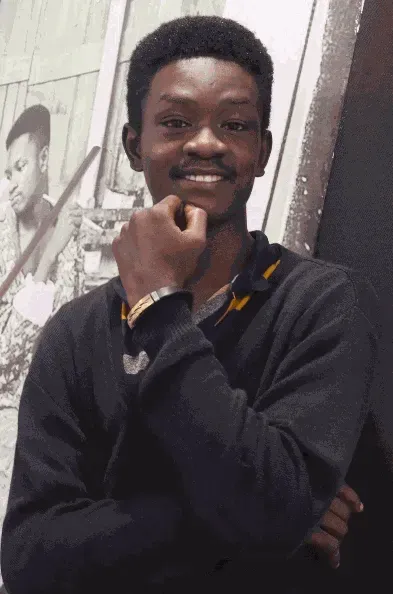Joseph Kojo Hoggar

Joseph Kojo Hoggar was born in Ghana in 1999, and freshly graduated in Visual Arts from the Kwame Nkrumah University of Science and Technology (KNUST); he is one of the most brilliant elements of his generation. The Vanities exhibition reveals his work around the great classic works of art history and his fascination for the figure of the smoker.
In his first year of study at KNUST, Joseph Hoggar devoted it to the theme of the roller and smoker of cigarettes and the consequences of smoking on his own body: red eyes and black lips. His observations support his perception, widespread in Africa, that tobacco makes you impure.
The CHRISTOPHE PERSON Gallery is currently hosting Joseph Kojo Hoggar’s first monographic exhibition.
The Vanities exhibition reveals his work inspired by the Old Master's classical works of art history and his fascination for the figure of the smoker. He included these marks in his compositions, and his first works attempted to represent the interior of smokers’ houses. Subsequently, his paintings were inspired by the still lifes of the old masters, loaded with symbolic objects similar to those of the Dutch Vanities.
There are objects of curiosity, lanterns, fruits, oranges, symbols of exoticism as it was perceived in the 16th and 17th centuries, and skulls, symbols of death in all civilizations. This fascination for European Old Masters emanates as much from his university courses as from his personal research.
The Water Maid is an interpretation of The Milkmaid by Vermeer. The figure of the maid is pouring water from a glass container in a white ceramic bowl. Water in most cultures is symbolic of purification. On the table are placed other symbolic objects such as an empty wine glass, which symbolizes fragility and death; fruits, perishable foodstuffs, already wasted; bottled wine, a phallic image of one who lives a wasted life. Finally, the skull on the table represents life's fatality. The two ends of butts in front of the skull put the final point of the representation of a woman in the service of a man, whom she deludes himself that he will be able to change his life for the better when we have all the clues that he wastes his.

In Tally Table (2022), freely inspired by Leonardo Da Vinci's The Last Supper, the models were photographed wearing the clothes that the artist then applied and sewed on the canvas. They are in yellow uniforms specific to Ghanaian schoolchildren.

The central female Christ figure rolls a cigarette, taking up the artist's leitmotif. Eleven of the apostles are present around the young woman, busy around the preparation of a set of short straws heralding the betrayal of Judas. The skull and the manuscripts predict events to come: the torture, the death of Christ and the writing of the New Testament. The washing of Christ's feet is evoked through the legs of the young woman. The folded garment to the left of the table suggests the existence and absence of Judas and the mantle of Christ that his executioners will share.
Self irony (2022) is a self-portrait of the artist, similar to those produced by European painters. With the presence of very contemporary elements, Joseph Kojo Hoggar plays with the current selfie fashion by replacing the mirror with a Mac Book to take his self-portrait. Once again, in ambush behind this exercise in celebration of youth, the skull recalls the perspective of old age and the end of life. By indulging in his vice as a smoker, the artist bit into the apple (from the Mac Book) and signed the end of innocence. The portrait, which seems to have been made with brush strokes and a magic wand, will be the only witness to this ephemeral beauty. Hoggar playfully uses the devices of mise en abyme, duplications and mirrors, traditionally present in the Vanities.
Work

Learn more about Joseph Kojo Haggar

https://www.christopheperson.com/artists/40-joseph-kojo-hoggar/works/






